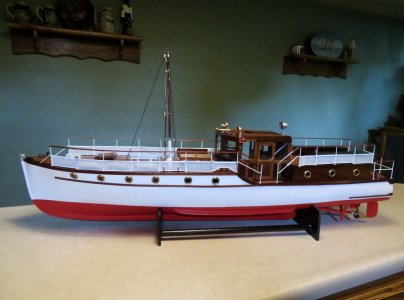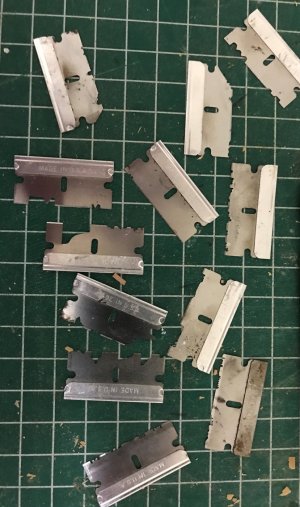In the process of finishing up an AMATI Fifie and am sanding the second planking layer. This is walnut and is taking an inordinate number of hours to get a good smooth hull configuration. I started by using,120 grit sand paper but am now using 80 grit just to take the edges off the planks to round them into rough shape. I'll go back to 120 then finish with 220 grit or finer. Since this is a painted hull, some scratches will be filled with a fairly heavy primer (it's going to be a radio control model). This now is my question for any future models - is walnut a real pain and is there a better choice in outer hull (2nd layer) woods?
-
LUCZORAMA SHIPWRECK SCAVENGER HUNT GIVEAWAY. 4 Weeks of Fun • 1 Legendary Prize ((OcCre’s Fram Ship)) • Global Crew Welcome!
**VIEW THREAD HERE**
You are using an out of date browser. It may not display this or other websites correctly.
You should upgrade or use an alternative browser.
You should upgrade or use an alternative browser.
There are species that are less brittle and more tight grained such as boxwood, castello, Alaskan cedar, and others. It comes down to cost in many instances. Some walnut species vary in graininess, figure and brittleness so many modelers do not like to use it but others love the color.is walnut a real pain and is there a better choice in outer hull
Allan
Last edited:
- Joined
- Mar 11, 2024
- Messages
- 55
- Points
- 78

what thickness are you using ? 2nd planking is usually 0.5-0.6 mm thick, you can sand right through it if you sneeze at the wrong moment! Walnut is, in my experience, only slightly more resistant than other woods,, i use it a lot and rather like it for it's colour.
if its being painted and intended to be a pond boat, why not fiberglass it? it seems a waste using such a beautiful wood that will be hidden anyway. why not use a cheaper wood more suited for its intended use?
Thanks for the comments. OK, too late to change plank wood as it is fully planked with 1x5 mm walnut - which is sanding like iron. As to 'glassing it, that may happen yet but it may just get a coat of resin inside and out for waterproofing. As to any future planked model, you can be assured that walnut will not be the final layer especially if the hull is as curvaceous d as this Amati Fifie.
I agree with Paul Ron, if it's going to be painted and made RC it could be planked with and type of wood you choose. Here is a photo of my scratch built BlueBird of Chelsea planked with pine, epoxy on the inside and fibreglass on the exterior hull. She was built that way to keep her perfectly dry inside and out as it is RC.


- Joined
- Apr 8, 2024
- Messages
- 4
- Points
- 18
A suggestion for fairing is to use a scraper. I also make violins and have to thin figured maple for ribs that end up 1.2-1.5 mm thick. I use scrapers of various shapes to gently remove material from the stock. I discovered that metal strapping from crates is ideal for making scrapers. By cutting the stapping with tin snips and using files to refine the shape I can make an assortment of scrapers for all scenarios. One must learn to burnish an edge on the scraper and many excellent videos are available on YouTube for this process.In the process of finishing up an AMATI Fifie and am sanding the second planking layer. This is walnut and is taking an inordinate number of hours to get a good smooth hull configuration. I started by using,120 grit sand paper but am now using 80 grit just to take the edges off the planks to round them into rough shape. I'll go back to 120 then finish with 220 grit or finer. Since this is a painted hull, some scratches will be filled with a fairly heavy primer (it's going to be a radio control model). This now is my question for any future models - is walnut a real pain and is there a better choice in outer hull (2nd layer) woods?
I have regular scrapers but possibly too large to use on a model but the steel banding may be worth a try - assuminin I can find some scrap pieces. I had some ~1" that I used for odds and ends but didn't survive the downsize move. I'll root arond behind Home Depot/Lowe's and see if I can find some thereA suggestion for fairing is to use a scraper. I also make violins and have to thin figured maple for ribs that end up 1.2-1.5 mm thick. I use scrapers of various shapes to gently remove material from the stock. I discovered that metal strapping from crates is ideal for making scrapers. By cutting the stapping with tin snips and using files to refine the shape I can make an assortment of scrapers for all scenarios. One must learn to burnish an edge on the scraper and many excellent videos are available on YouTube for this process.
- Joined
- Jun 29, 2024
- Messages
- 964
- Points
- 353

Single edged razor blades can be used as scrapers.
I got a box of them from a hair stylist years ago when she considered them too dull for a perfect cut on hair. They sure work well for scraping or cutting small pieces of wood.Single edged razor blades can be used as scrapers.
- Joined
- Apr 12, 2025
- Messages
- 231
- Points
- 103

I'm also a big proponent of fiber glassing the exterior of a hull that will be in real water, as aside from water-tight integrity, it also offers additional strength for when you beach your boat, or bump into those unseen things floating just below the surface of the water. It doesn't take much to crack plain epoxy resin if it isn't supported with any cloth... and then "there goes that water-tight integrity!"
- Joined
- Sep 8, 2024
- Messages
- 130
- Points
- 78

As soon as you said “paint” the rules change. You can use anything under a layer of paint, and you can use an abrasive that’s coarse to ensure a good key to the primer. An old fashioned painter’s tip is to add some plaster to paint to act as a filler. Only needs a bit, it piles into your 80 grit scratches to fill them , is well bound into the paint, and sands nicely to glass smooth surface for the undercoats- rubbing back each time.
Another handy idea is to vary your undercoat colour by a few shades on each layer. It shows up if you miss any, and it witnesses if you abrade through to the layer below.
(Makes brilliant white on top of brilliant white much easier to ensure even coats)
Jim
Another handy idea is to vary your undercoat colour by a few shades on each layer. It shows up if you miss any, and it witnesses if you abrade through to the layer below.
(Makes brilliant white on top of brilliant white much easier to ensure even coats)
Jim



